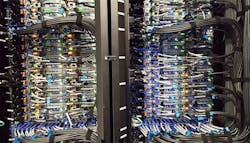Internet exchanges around the world recorded record traffic peaks on Tuesday, driven by increased Internet use related to the spread of Coronavirus, and the release of a new Call of Duty game.
The surge in network traffic underscores the important role digital infrastructure is playing in adapting social and business behavior to slow the spread of the Coronavirus, which has been connected with more than 4,300 deaths globally as of March 11.
A key strategy to slow the spread of the virus is social distancing and avoiding crowds. Many large global firms have directed employees to work from home, including Google, Twitter, Amazon and Microsoft. The “WFH” trend is expected to grow in coming days as cases rise in the United States and Europe. Meanwhile, major universities are shifting to online delivery of courses, a practice adopted at Stanford, Harvard, Princeton and USC.
These decisions by businesses and schools increase their reliance on data networks that provide video streaming and collaboration. Network ops firm Kentik said it has “seen roughly a 200 percent increase in video conferencing during working hours” in North America and Asia amid the Coronavirus spread.
On Tuesday, the elevated business traffic collided with the release of “Call of Duty: Warzone,” the latest edition of the popular first-person shooter video game. The download for the game update is between 18 to 23 GB in size, depending on platform. The release created network congestion and delays on major Internet backbones, as well as record traffic.
DE-CIX Frankfurt, one of the world’s busiest interconnection hubs, reported a new all-time traffic peak of more than 9.1 Terabits per second on Tuesday evening, an increase of 800 Gigabits per second (Gbps) seen two weeks ago. The exchange said it had anticipated it might reach levels of 9 Tbps, but not until later this year.
“Whether it’s for exchanging information, streaming films, playing online games, or the exceptional situation people are currently experiencing with the COVID-19 virus, Internet usage is playing an ever-greater role,” said Dr. Thomas King, Chief Technology Officer of DE-CIX. “Guaranteeing a stable and secure Internet infrastructure – regardless of how challenging the times are – is one of our highest priorities.”
DE_CIX wasn’t alone, as records were also seen at Internet exchanges in multiple countries.
Internet use will likely increase further in coming days as more companies shift to the work from home model, and universities begin to deliver courses online. There’s a growing likelihood that many U.S. public school systems will also shift to online classwork.
School closures in China prompted a huge spike in downloads of applications for online work and education, according to data from Sensor Tower, with a jump in downloads for Alibaba’s remote work app DingTalk and Tencent Meeting.
This chart from Sensor Tower shows a huge spike in downloads of apps for remote work and education. (Image: Sensor Tower)
“We tend to think about supply chains as physical goods that move around the world,” tweeted Aaron Levie, the CEO of storage provider Box. “Covid-19 has quickly exposed the dependencies to a company’s ‘knowledge work’ value chain.”
That thought was echoed by Marc Ganzi, CEO of Digital Bridge, part of Colony Capital network of digital infrastructure companies, which includes fiber, cell towers and data center operators DataBank and Vantage.
“As the world deals with uncertainty, the digital economy continues to enable the global economy to keep moving,” said Marc Ganzi, CEO of Digital Bridge, part of Colony Capital. “Telecommuting via video conferencing on applications like Zoom, Microsoft Teams, Cisco and Slack are key examples of our customers helping the world’s leading enterprises enable and conduct commerce.”






